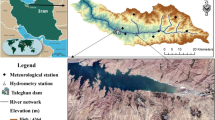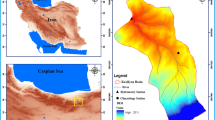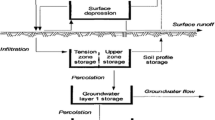Abstract
The outputs of Rainfall-runoff models are inherently uncertain and quantifying the associated uncertainty is crucial for water resources management activities. This study presents the uncertainty quantification of rainfall-runoff simulations using the copula-based Bayesian processor (CBP) in Danjiangkou Reservoir basin, China. The seasonality of uncertainty in rainfall-runoff modeling is explored, and impacts of copula selection and correlation coefficient on uncertainty quantification results are investigated. Results show that the overall performance of the CBP is satisfactory, which provides a useful tool for estimating the uncertainty of rainfall-runoff simulations. It is also demonstrated that the dry season has higher reliability and greater resolution compared with wet season, which illustrates that the CBP captures the actual uncertainty of rainfall-runoff simulations more accurately in dry season. Moreover, the performance the CBP highly depends on the selected Copula function and considered Kendall tau correlation coefficient. As a result, great attention should be paid to selecting the appropriate Copula function and effectively capturing the actual dependence between observed and simulated flows in the CBP-based uncertainty quantification of rainfall-runoff simulations practice.





Similar content being viewed by others
Data Availability
Data available after request from the corresponding author.
References
Al-Juboori AM (2022) Solving complex rainfall-runoff processes in semi-arid regions using hybrid heuristic model. Water Resour Manag 36(2):717–728
Biondi D, De Luca DL (2013) Performance assessment of a Bayesian Forecasting System (BFS) for real-time flood forecasting. J Hydrol 479:51–63
Biondi D, Versace P, Sirangelo B (2010) Uncertainty assessment through a precipitation dependent hydrologic uncertainty processor: An application to a small catchment in southern Italy. J Hydrol 386(1–4):38–54
Castellarin A, Vogel RM, Brath A (2004) A stochastic index flow model of flow duration curves. Water Resour Res 40(3). https://doi.org/10.1029/2003WR002524
Dakhlaoui H, Djebbi K (2021) Evaluating the impact of rainfall–runoff model structural uncertainty on the hydrological rating of regional climate model simulations. J Water Clim Change 12(8):3820–3838
Dung NV, Merz B, Bárdossy A, Apel H (2015) Handling uncertainty in bivariate quantile estimation—An application to flood hazard analysis in the Mekong Delta. J Hydrol 527:704–717
Feng K, Zhou J, Liu Y, Lu C, He Z (2019) Hydrological uncertainty processor (HUP) with estimation of the marginal distribution by a Gaussian mixture model. Water Resour Manag 33(9):2975–2990
Fraga I, Cea L, Puertas J (2019) Effect of rainfall uncertainty on the performance of physically based rainfall–runoff models. Hydrol Process 33(1):160–173
Ghaith M, Li Z (2020) Propagation of parameter uncertainty in SWAT: A probabilistic forecasting method based on polynomial chaos expansion and machine learning. J Hydrol 124854
Gopalan SP, Kawamura A, Amaguchi H, Takasaki T, Azhikodan G (2019) A bootstrap approach for the parameter uncertainty of an urban-specific rainfall-runoff model. J Hydrol 579:124195
Guo SL, Guo J, Zhang J, Chen H (2009) VIC distributed hydrological model to predict climate change impact in the Hanjiang Basin. Sci China Ser E 52(11):3234–3239
Han S, Coulibaly P, Biondi D (2019) Assessing hydrologic uncertainty processor performance for flood forecasting in a semiurban watershed. J Hydrol Eng 24(9):05019025
Hosking JRM (1990) L-moments: analysis and estimation of distributions using linear combinations of order statistics. J R Stat Soc B 52(1):105–124
Jiang X, Liang Z, Qian M, Zhang X, Chen Y, Li B, Fu X (2019) Method for probabilistic flood forecasting considering rainfall and model parameter uncertainties. J Hydrol Eng 24(12):04019056
Knoben WJM, Freer JE, Peel MC, Fowler KJA, Woods RA (2020) A brief analysis of conceptual model structure uncertainty using 36 models and 559 catchments. Water Resour Res 56(9):e2019WR025975
Krzysztofowicz R, Kelly KS (2000) Hydrologic uncertainty processor for probabilistic river stage forecasting. Water Resour Res 36(11):3265–3277
Li W, Zhou JZ, Sun HW, Feng KL, Zhang HR, Tayyab M (2017) Impact of distribution type in bayes probability flood forecasting. Water Resour Manag 31:961–977
Li N, Guo S, Xiong F, Wang J, Xie Y (2022) Comparative study of flood coincidence risk estimation methods in the mainstream and its tributaries. Water Resour Manag 36(2):683–698
Liu ZJ, Guo SL, Xiong LH, Xu CY (2018) Hydrological uncertainty processor based on a copula function. Hydrolog Sci J 63(1):74–86
Liu ZJ, Guo SL, Zhang HG, Liu DD, Yang G (2016) Comparative study of three updating procedures for real-time flood forecasting. Water Resour Manag 30(7):2111–2126
Moges E, Demissie Y, Larsen L, Yassin F (2021) Review: Sources of hydrological model uncertainties and advances in their analysis. Water. https://doi.org/10.3390/w13010028
Motevali BNE, Akhoond-Ali AM, Radmanesh F, Koupai JA, Soltaninia S (2021) Comparison of the calculated drought return periods using tri-variate and bivariate copula functions under climate change condition. Water Resour Manag 35(14):4855–4875
Pappenberger F, Ramos MH, Cloke HL, Wetterhall F, Alfieri L, Bogner K, Salamon P (2015) How do I know if my forecasts are better? Using benchmarks in hydrological ensemble prediction. J Hydrol 522:697–713
Ragab R, Alexandra K, Muhammad A, Ioanna P (2020) Application of Generalized Likelihood Uncertainty Estimation (GLUE) at different temporal scales to reduce the uncertainty level in modelled river flows. Hydrolog Sci J 65(11):1856–1871
Razmi A, Mardani-Fard HA, Golian S, Zahmatkesh Z (2022) Time-varying univariate and bivariate frequency analysis of nonstationary extreme sea level for New York City. Environ Process 9(1):1–27
Safarpour H, Tabesh M, Shahangian SA (2022) Environmental assessment of a wastewater system under water demand management policies. Water Resour Manag 36(6):2061–2077
Sepúlveda UM, Mendoza PA, Mizukami N, Newman AJ (2022) Revisiting parameter sensitivities in the variable infiltration capacity model across a hydroclimatic gradient. Hydrol Earth Syst Sc 26(13):3419–3445
Shen Y, Liu D, Yin J, Xiong L, Liu P (2020) Integrating hybrid runoff generation mechanism into variable infiltration capacity model to facilitate hydrological simulations. Stoch Env Res Risk 34(12):2139–2157
Wu C, Yeh PJF, Che YY, Lv W, Hu BX, Huang G (2021) Copula-based risk evaluation of global meteorological drought in the 21st century based on CMIP5 multi-model ensemble projections. J Hydrol 598:126265
Xiong L, Du T, Xu CY, Guo S, Jiang C, Gippel CJ (2015) Non-Stationary annual maximum flood frequency analysis using the norming constants method to consider non-Stationarity in the annual daily flow series. Water Resour Manag 29(10):3615–3633
Yang G, Guo SL, Li LP, Hong XJ, Wang L (2016) Multi-objective operating rules for Danjiangkou Reservoir under climate change. Water Resour Manag 30(3):1183–1202
Yang X, Zhou J, Fang W, Wang Y (2020) An ensemble flow forecast method based on autoregressive model and hydrological uncertainty processor. Water. https://doi.org/10.3390/w12113138
Yao S, Chen N, Du W, Wang C, Chen C (2021) A cellular automata based rainfall-runoff model for urban inundation analysis under different land uses. Water Resour Manag 35(6):1991–2006
Yao Y, Liang Z, Zhao W, Jiang X, Li B (2019) Performance assessment of hydrologic uncertainty processor through integration of the principal components analysis. J Water Clim Change 10(2):373–390
Zhou JZ, Feng KL, Liu Y, Zhou C, He FF, Liu GB, He ZZ (2020) A hydrologic uncertainty processor using linear derivation in the normal quantile transform space. Water Resour Manag 34:3649–3665
Zhou S, Wang Y, Li Z, Chang J, Guo A (2021) Quantifying the uncertainty interaction between the model input and structure on hydrological processes. Water Resour Manag 35(12):3915–3935
Acknowledgements
This research was funded by the National Natural Science Foundation of China (51909112), Major Discipline Academic and Technical Leaders Training Program of Jiangxi Province (20212BCJ23016) and Jiangxi Provincial Water Resources Science and Technology Project (202023ZDKT02).
Author information
Authors and Affiliations
Contributions
Conceptualization, methodology, formal analysis, investigation, and writing original draft preparation, Zhangjun Liu; Data curation, Writing, review and editing, Jingwen Zhang; Resources, Supervision and updating some parts, Tianfu Wen and Jingqing Cheng.
Corresponding author
Ethics declarations
Ethical Approval
The authors declare that they have no conflict of interest.
Consent to Participate
The authors declare that they are aware and consent with their participation on this paper.
Consent to Publish
The authors declare that they are consent with the publication of this paper.
Competing Interests
There is not any competing interest.
Additional information
Publisher's Note
Springer Nature remains neutral with regard to jurisdictional claims in published maps and institutional affiliations.
Rights and permissions
Springer Nature or its licensor holds exclusive rights to this article under a publishing agreement with the author(s) or other rightsholder(s); author self-archiving of the accepted manuscript version of this article is solely governed by the terms of such publishing agreement and applicable law.
About this article
Cite this article
Liu, Z., Zhang, J., Wen, T. et al. Uncertainty Quantification of Rainfall-runoff Simulations Using the Copula-based Bayesian Processor: Impacts of Seasonality, Copula Selection and Correlation Coefficient. Water Resour Manage 36, 4981–4993 (2022). https://doi.org/10.1007/s11269-022-03287-x
Received:
Accepted:
Published:
Issue Date:
DOI: https://doi.org/10.1007/s11269-022-03287-x




